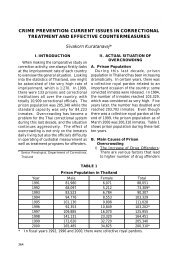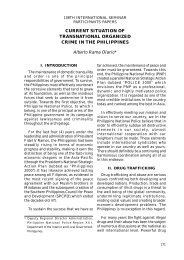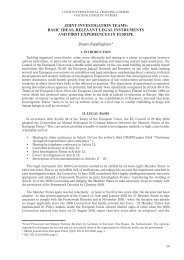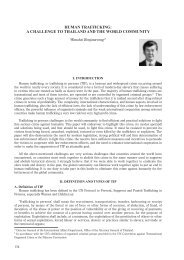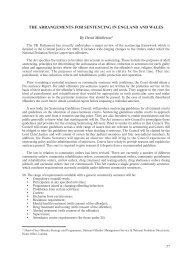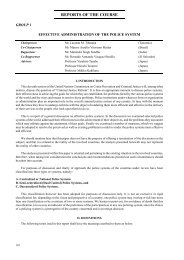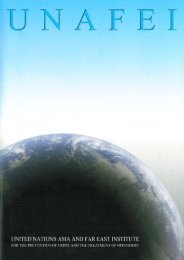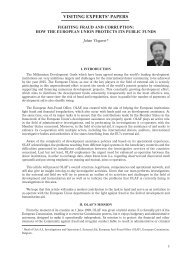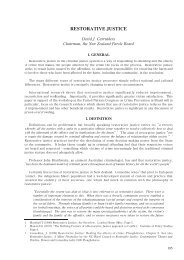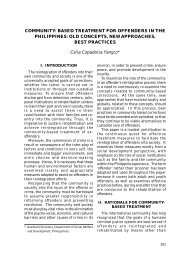CANADA'S ANTI-MONEY LAUNDERING REGIME Daniel P. Murphy *
CANADA'S ANTI-MONEY LAUNDERING REGIME Daniel P. Murphy *
CANADA'S ANTI-MONEY LAUNDERING REGIME Daniel P. Murphy *
Create successful ePaper yourself
Turn your PDF publications into a flip-book with our unique Google optimized e-Paper software.
RESOURCE MATERIAL SERIES No. 58light of Canada’s constitutional frameworkand its Charter. Our Charter normallyrequires a prior judicial authorizationbefore an agent of the state, such as thenew Centre, obtains information. 23 Thishad a significant impact upon the draftersas the new law developed. The RCMP, asa law enforcement agency, could not hostthe Centre without creating a Charter risk.Essentially, if a law enforcement agency,directly or through a subsidiary part of theenforcement agency, obtained personalinformation without a warrant. It operatesunder a significant section 8 Charter risk.The solution was to establish a newindependent agency.This new Centre was deliberatelyestablished without investigative powers.The law also placed significant restrictionson the amount of data that the Centre coulddivulge to investigators. 24 Otherwise, theCentre’s information collection activityactivities would be challenged. Itsauthority to collect suspicious or proscribedtransaction reports may have been seen asa backdoor device for law enforcement. TheCharter required law enforcement to usesearch warrants and similar priorauthorizations. The new Centre was adeliberate choice in the Proceeds of Crime(Money Laundering) Act as a suitablecompromise to undertake a regulatory andanalysis function, rather than a lawenforcement function.When fully implemented, the Act repealsits predecessor. Structurally, the Actconsists of five parts. Part I containsspecific objects 25 which define the purposesfor the legislation. This Part obliges adesignated business to make and maintainrecords; report either questionable (i.e.suspicious) or prescribed financialtransactions 26 to the new Centre. Therecord keeping and maintenance provisionswill continue to facilitate an investigativepaper trail. Law enforcement will have to22 This is best seen in the work of the Egmont Group.)23 The seminal Supreme Court of Canada’s decisionon point is R. v. Hunter and Southam [1984] 2 S.C.R14524 Section 55 first states that the Centre may notdisclose the information it collects, other than underthe provisions set out in subsection 55(3), (4) and(5). Those subsections provide, as follows :(3) If the Centre, on the basis of its analysis andassessment under paragraph 54(c), hasreasonable grounds to suspect that designatedinformation would be relevant to investigatingor prosecuting a money laundering offence, theCentre shall disclose the information to(a) the appropriate police force;(b) the Canada Customs and Revenue Agency,if the Centre also determines that theinformation is relevant to an offence ofevading or attempting to evade paying taxesor duties imposed under an Act ofParliament administered by the Minister ofNational Revenue;(c) the Canadian Security Intelligence Service,if the Centre also determines that theinformation is relevant to threats to thesecurity of Canada within the meaning ofsection 2 of the Canadian SecurityIntelligence Service Act; and(d) the Department of Citizenship andImmigration, if the Centre also determinesthat the information would promote theobjective set out in paragraph 3(j) of theImmigration Act and is relevant todetermining whether a person is a persondescribed in subsection 19(1) or (2) or section27 of that Act or to an offence under section94.1, 94.2, 94.4, 94.5 or 94.6 of that Act.(4) The Centre may disclose designatedinformation to an institution or agency of aforeign state or of an international organizationestablished by the governments of foreign statesthat has powers and duties similar to those ofthe Centre if(a) the Centre has reasonable grounds to292




